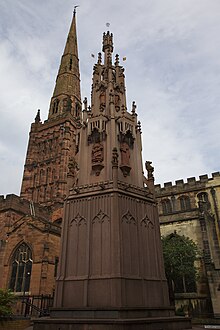Coventry Cross (monument)

The replica of the cross was erected in 1976.
|
|
| Coordinates | 52°24′30″N 1°30′31″W / 52.40822°N 1.50858°WCoordinates: 52°24′30″N 1°30′31″W / 52.40822°N 1.50858°W |
|---|---|
| Location | Coventry |
| Type | Market Cross |
| Beginning date | c.1300, 1423, 1544, 1976 |
Coventry Cross is an important landmark in the cathedral city of Coventry, England. Standing between Cuckoo Lane and Holy Trinity Church and in the alley known as Trinity Churchyard, it is a modern version of the historic market cross, such as was common in many medieval market towns.
From medieval times, a cross stood at the southern end of Cross Cheaping, where it met Broadgate, about 100 metres from where the new one stands. This was the market place, and place of executions, and the earliest reference to a cross here is in a document dated 1300. This cross would probably have been carved from local red sandstone in the shape of a tall shaft topped with a simple cross, as was the style in the rest of the city and surrounding area.
On 24 May 1423 the court-leet ordered that a new cross be made and on the Thursday after Saint Matthias day in 1423 the mayor, Henry Peyto, held a meeting in St Mary’s hall which officially sanctioned the building of a cross in Cross Cheaping. The Leet contributed £50 and the mayor also made a personal contribution to pay for it. The City Annals describe this cross as standing on eight pillars, and it stood for over a hundred years before it became unsafe and part of the upper section had to be taken down in 1537.
By 1506 discussions had already begun about replacing it, and a fund started. In 1541, a former mayor of London, Sir William Hollyes, who had been born in Stoke, Coventry, left £200 in his will for a new cross, and building started the same year.
An indenture details how the cross was to be made, based on one in Abingdon, Berkshire, and made of ‘seasonable free-stone of the quarries of Attleborough and Rowington’. It was to be built on the same spot as the old cross and on every pinnacle of the lower storey have ‘a beast or fowl holding up a fan’. On each pinnacle of the second storey there was to be ‘the image of a naked boy with a target and holding up a fan’. The cross was 57 feet high, in four sections, with statues in the top three storeys: the lower of these holding statues of Henry VI, King John, Edward I, Henry II, Richard I and Henry. Above these were Edward III, Henry II, Richard III, St Michael and St George. The top storey held statues of St Peter, St James, St Christopher and two monks, with representations of Liberty and Justice at the highest point. Several of these statues were said to have been taken from Whitefriars and set in the cross. The new Coventry Cross was completed in 1544. It was brightly painted, and covered with gold. The city Treasurers Accounts of 1545 include the entry 'To Matthew Gilder for gildyng the crosse £8 6s. 8p.' The nearby Golden Cross public house, erected some 40 years later at 8 Hay Lane, was probably named after it, as well as the 16th-century Coventry Cross public house at 29 Cross Cheaping.
...
Wikipedia
